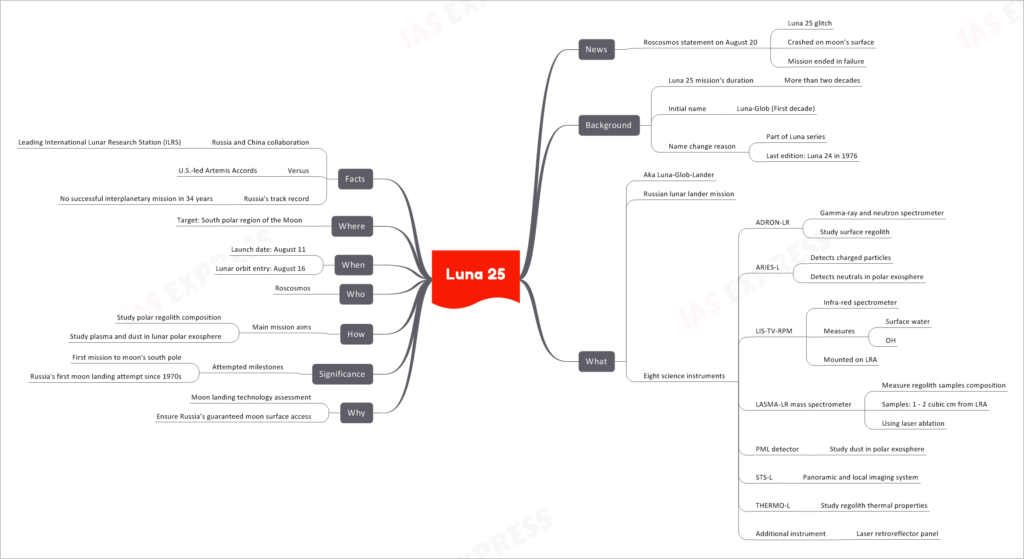Luna 25

In recent news, Russia’s lunar exploration mission, Luna 25, has encountered a setback as it crashed onto the moon’s surface. The mission’s failure, announced by Roscosmos on August 20, has raised questions about Russia’s endeavors in space exploration and its implications on international space collaboration.
Background: Decades in the Making
The Luna 25 mission’s roots extend over two decades, highlighting Russia’s enduring commitment to lunar exploration. Initially known as Luna-Glob, the mission underwent a name change to Luna 25 as part of the longstanding Luna series. The decision was influenced by the historical significance of the Luna series and its previous edition, Luna 24, which took place in 1976.
The Luna 25 Mission: A Scientific Endeavor
Luna 25, also known as Luna-Glob-Lander, represents Russia’s attempt at a lunar landing mission, equipped with eight sophisticated science instruments aimed at unraveling the moon’s mysteries:
- ADRON-LR: A gamma-ray and neutron spectrometer designed to study the composition of the moon’s surface regolith.
- ARIES-L: A particle detector geared towards detecting charged particles and neutrals in the polar exosphere.
- LIS-TV-RPM: An infra-red spectrometer mounted on the Lander Retroreflector Array (LRA) to measure surface water and OH.
- LASMA-LR Mass Spectrometer: This instrument employs laser ablation to analyze regolith samples’ composition.
- PML Detector: Designed to study dust in the lunar polar exosphere.
- STS-L: A comprehensive imaging system for panoramic and local imaging.
- THERMO-L: An instrument tasked with studying the thermal properties of the lunar regolith.
- Additional Instrument: A laser retroreflector panel.
The Quest: Why Luna 25?
The Luna 25 mission serves as a technology assessment for moon landings and a strategic move to ensure Russia’s guaranteed access to the moon’s surface. This endeavor is pivotal in evaluating lunar landing capabilities and advancing Russia’s presence in space exploration.
Significance and Aspirations
Luna 25 embarked on two key milestones: it aimed to become the first mission to explore the moon’s south pole and marked Russia’s first lunar landing attempt since the 1970s. These ambitious goals underscore Russia’s renewed interest in lunar exploration and its determination to contribute to our understanding of the moon’s terrain and composition.
Mission Objectives: Unveiling Lunar Mysteries
The primary goals of Luna 25 included the in-depth study of the lunar polar regolith composition and the analysis of plasma and dust within the moon’s polar exosphere. These objectives were aimed at uncovering insights into the moon’s geological and atmospheric properties.
The Driving Force: Roscosmos
Roscosmos, the Russian space agency, is the driving force behind the Luna 25 mission. With a history of space exploration, Roscosmos has taken the lead in this lunar exploration endeavor.
Mission Timeline: Dates and Destinations
Luna 25’s journey began on August 11 with its launch and successfully entered lunar orbit on August 16. The mission’s target destination was the south polar region of the moon, an area of great scientific interest.
International Collaborations and Competitions
Russia’s collaboration with China in leading the International Lunar Research Station (ILRS) highlights the potential for international partnerships in lunar exploration. This effort stands in contrast to the U.S.-led Artemis Accords, emphasizing diverse pathways for global lunar cooperation. Russia’s track record in interplanetary missions has been marked by challenges, with no successful mission accomplished in the past 34 years.
If you like this post, please share your feedback in the comments section below so that we will upload more posts like this.

